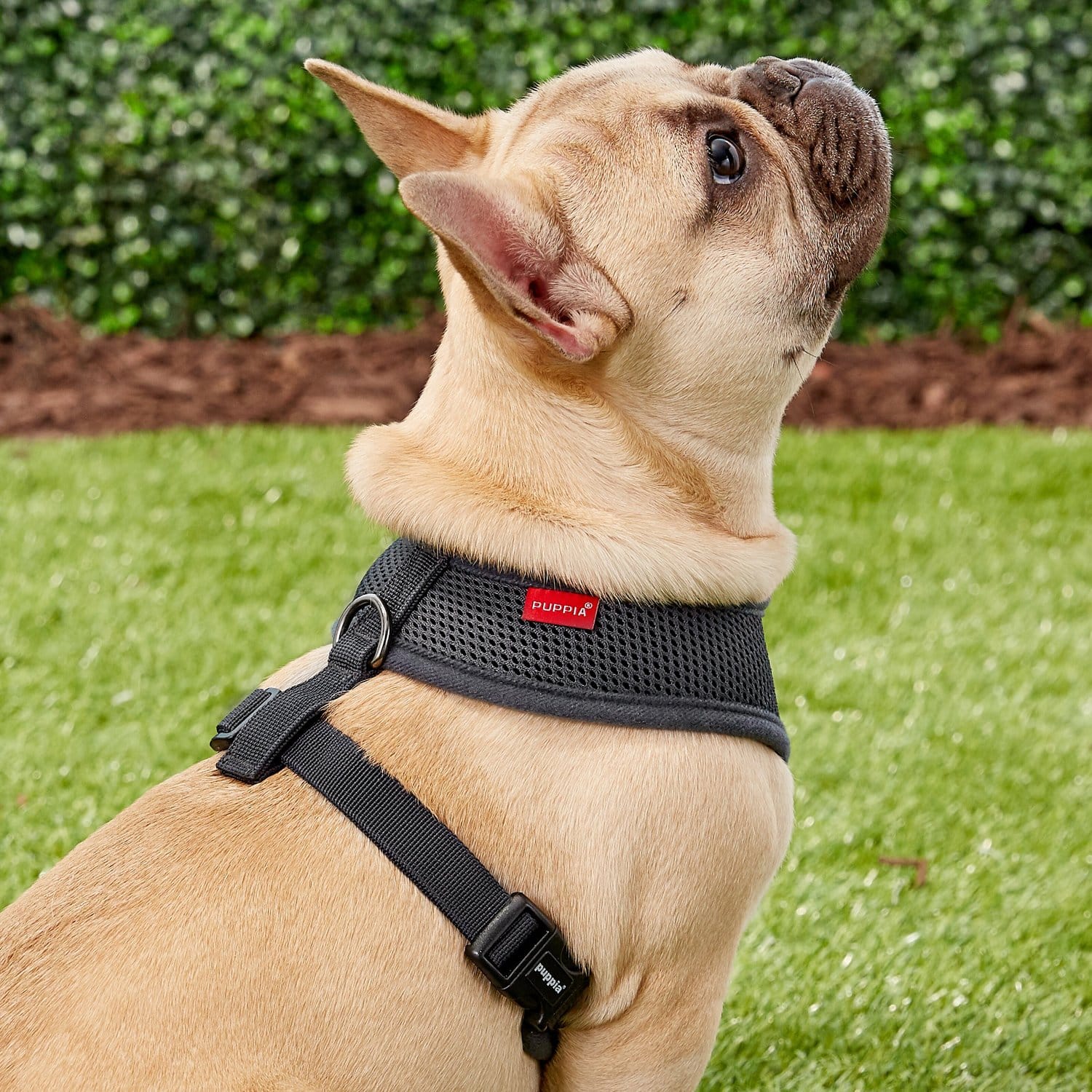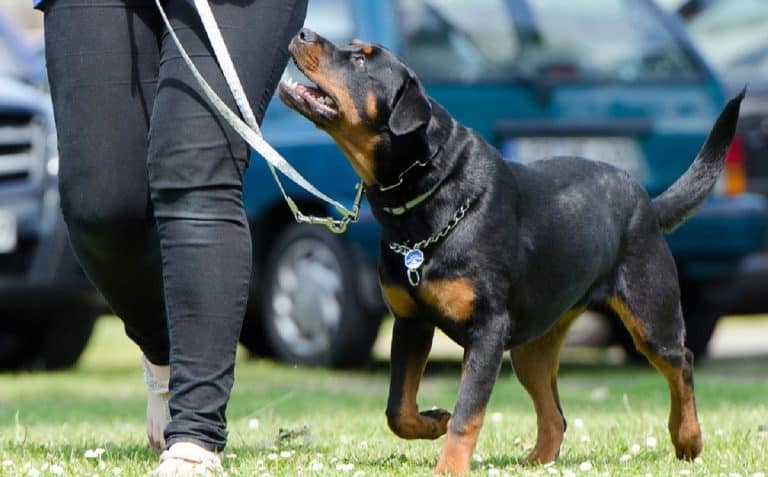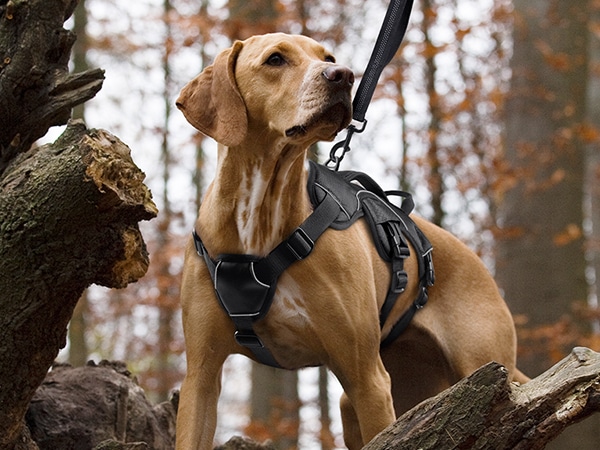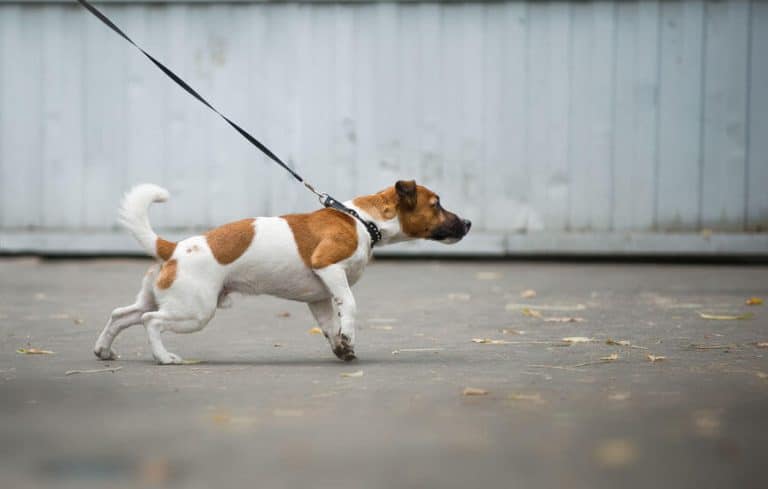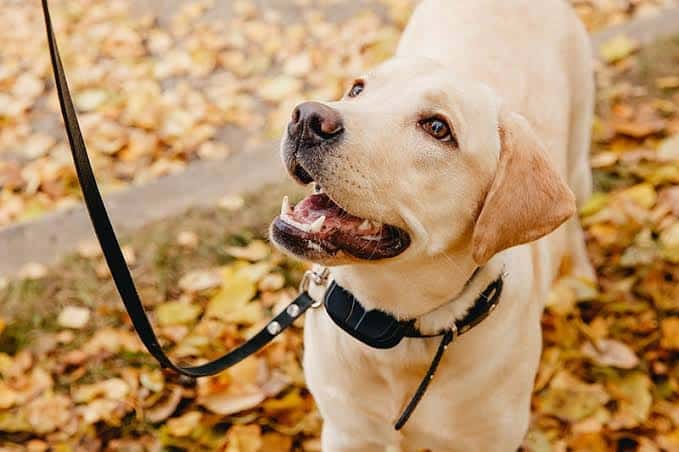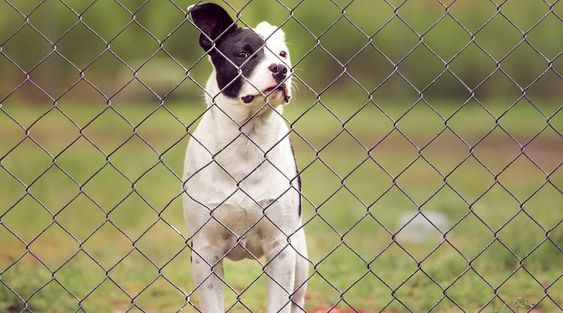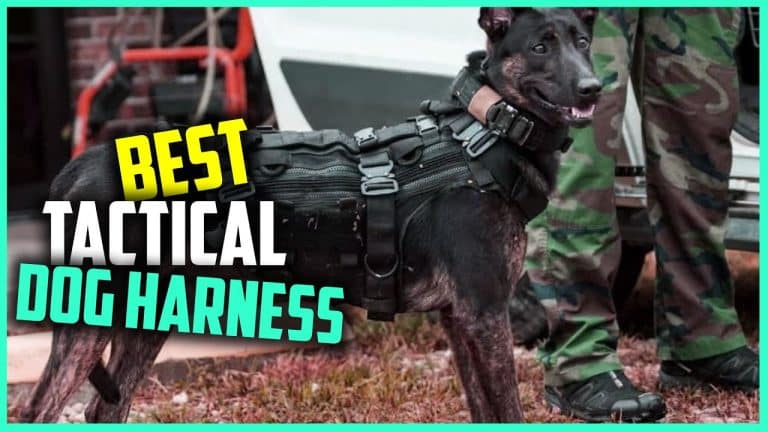How Does a Harness Go on a Dog
A dog harness provides control, comfort, and safety to your dogs. It has grown popular among pet owners due to the advantages it provides. These are quite different from collars as your dog does not have discomfort wearing them. There are many types of dog harnesses available in the market, and some of them have been discussed here.
There are certain factors that you need to keep in mind before purchasing a harness. You also need to know how tight or loose you need to keep it so that it does not leave marks or rashes on your dog’s body.
The best thing about harnesses is that most can be washed and customized for your dog.
What is a Dog Harness?
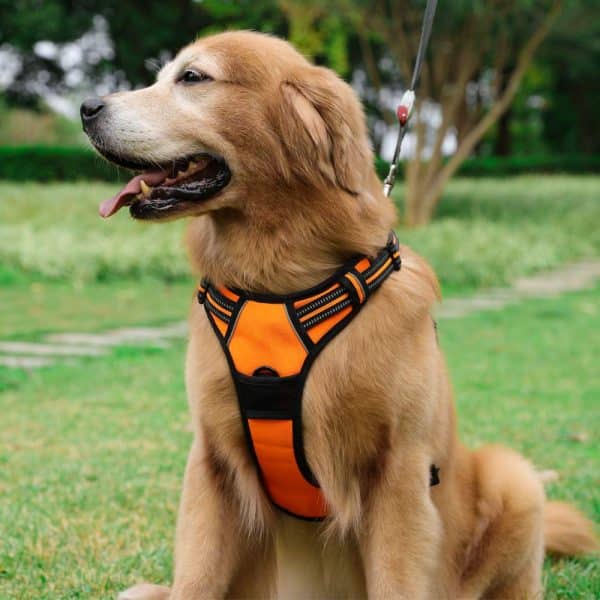
Dog harnesses are wearable equipment that dog owners use for their fur companions. Although harnesses are similar to a dog collar, they provide better safety and control. These are wrapped in a circle around a dog’s neck and fit around their torso. The straps are put behind their front legs and thus help distribute the pressure throughout the chest.
They are beneficial in guiding, holding, and lifting your dog. If you have a large dog that is pull-prone, you should use harnesses over a dog collar. The adjustable straps of a harness make it all the more apt for your fur companion.
Types of Dog Harnesses
There are many types of harnesses with their pros and cons. It would be best if you looked into what your dog needs and which one will suit them and your needs right.
Find out 7 types of dog harnesses below:
1. Tactical Harness
Tactical harnesses are used for large breeds or those that are taken for extreme hiking trips and sports. These are usually made out of sturdy materials, helping your dogs to stay in control and giving them the utmost safety.
2. Padded Chest Harness
These are one of the best types of harnesses as they reduce pressure points on your dog’s joints. They are available in various colors and provide ease and comfort to your dog due to the padding and cushioning.
3. Dual Strap Harness
These harnesses are very lightweight on your dog’s back and in front of the chest. They are great when you want to take them for walks outside. However, do not go for them if your dog is sturdy and strong.
4. Safety Dog Harness
These dog harnesses ensure that your dog does not run away anywhere. It is the best option when we bring home a rescued dog. You can get these harnesses for dogs that jump around too much or are too independent.
5. Weight Pulling Harness
These harnesses are best for dogs that are into working, like sled dogs or aggressive breeds. When training them or making them work, don’t forget to take care of their health. This harness can be attached to a sled or an object.
6. Halti Front Pull Harness
The Halti front harness is similar to a head halter harness. This helps you against the pills from your dog. It provides a safe training environment for your dogs. Police also use it to keep the dogs safe and in control when training them.
7. Step-In Vest Harness
Step-in harnesses and step-in vest harnesses are two different types of harnesses. These are great for those rescued dogs who do not like anyone touching them. However, they are not easily adjustable. They are best for small-breed dogs and are very stylish.
How Tight Should a Dog Harness Be?
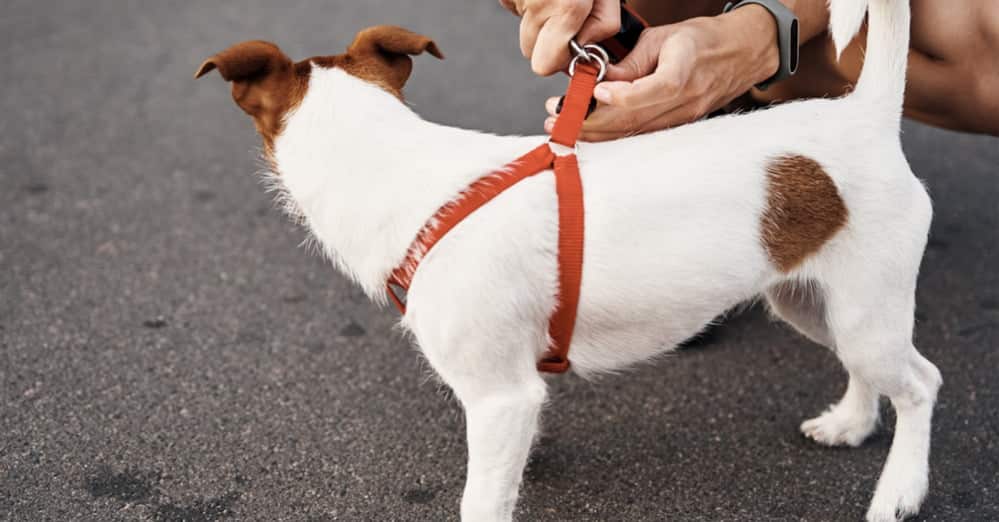
Having the right fit for your dog’s harness is essential. Only when the harness is of the right size can you ensure comfort, safety, and freedom for your dogs. If the harness you get for your dog is too big, it will slip-free, while if the harness is too tight, it can be painful for them.
To understand how tight the harness needs to be, you will have to check the right fit, and you can do so by following these steps:
- Step 1: The first thing to do is measure your dog. Measure your dog’s neck circumference, which is the base of the neck.
- Step 2: Next, measure the belly circumference of your dog. This is around an inch in front of your dog’s back legs.
- Step 3: Now, measure your dog’s body length. This measurement starts from behind the front leg and goes behind the back of the leg.
- Step 4: Get all these measurements ready and compare them with your dog’s size chart. When you buy a harness, you will receive a size chart list. Make sure you are buying the harness based on this chart.
- Step 5: If you feel that taking the measurement this way is difficult, take a thin towel and wrap it around your dog. Now, check it with the different harnesses you are checking.
- Step 6: Lastly, you can now check on the design of the harness that you would like to get for our dog.
Signs You Need to Look Out for a Harness that Does Not Fit Right
Find out how should a harness fit on a dog below:
- If chaffs are around the area where the harness is wrapped, you need to change the fit immediately.
- Another sign is that your dog might not walk when wearing this harness.
- If your dog is losing fur around the places where he wears the harness, it means the harness is too tight.
- When your dog tries to set himself free from the harness by wiggling, it means they are not comfortable wearing it.
Choosing a Harness Style Based on Their Breed
As discussed, measuring your dog’s girth before buying a harness is essential. However, some harnesses work perfectly well for certain breeds, and you do not need to take measurements.
1. Breeds that Need Small Harnesses
If your dog weighs anywhere between 18 pounds and 35 pounds and has a chest circumference of 17 inches to 22 inches, small harnesses are what you need to get. The breeds included in this category are pug, Scottish terrier, miniature schnauzer, and many more.
2. Breeds that Require Medium-Sized Harnesses
The medium-sized harness is perfect for a chest circumference of 22 inches to 27 inches, weighing between 30 pounds and 50 pounds. Beagle, french bulldog, border collie, and English bulldog are some breeds to name.
3. Breeds that Make Use of a Large Harness
You will need a large harness if your dog’s chest circumference is 27 inches to 32 inches and weighs more than 45 pounds. The right size will help breeds like Dalmatians, labrador retrievers, boxers, and weimaraners.
How Should You Adjust the Harness?
Applying a harness is easy, but only when you know the right way. Here is a detailed step on how to do that:
Step 1: Adjust the Neck Strap
Firstly, you need to identify the neck strap around the dog’s neck. Loosen the strap so that two fingers can slip in easily between the harness and your dog’s neck. If you can do that, the harness is neither right nor loose.
Step 2: Position the Chest Strap
Now, you need to check for the chest strap. This will cover your dog’s chest from behind the front legs. Adjust the straps well so that it is not too tight. Now check the fit by slipping your two fingers between the strap and your dog’s chest.
Step 3: Adjust the Girth Strap
The girth strap wraps around the torso of your dog. It would be best if you positioned it slightly behind the rib cage. You need to adjust it so that it is not too tight and gives enough comfort for your dog to move around wearing it.
Step 4: Align All the Straps
Once all the individual straps are adjusted in their respective positions, align the straps properly. There should not be any tangles or twists, thus maximizing the comfort of your dog. This removes any risks of irritation or rubbing.
Step 5: Check for Padding and Cushioning
Now, check if there is enough padding and cushioning for your dog. If your dog is sensitive and is long-haired, this will be very beneficial. In addition, cushioning will reduce any rubbing or irritation when your dog wears it for long hours.
Step 6: Secure the Harness
Once you have checked for all the adjustments of your straps and ensured that it is completely padded, you need to secure the harness of your dog. Make sure that the buckle is securely locked so that there are no accidental openings later on.
Pros and Cons of Harnesses and Collars
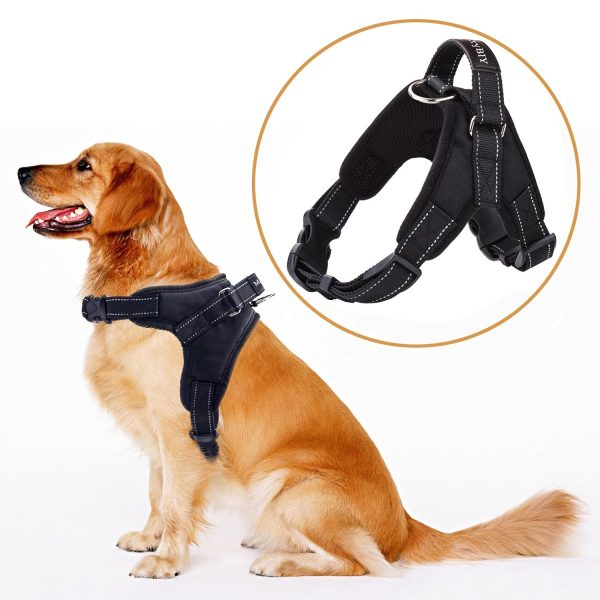
There are certain advantages and disadvantages to making your dog wear a harness. Find out about them in detail below.
Pros of a Harness
- You get a lot more control over your dog when using a harness since there are various pressure points and attachments available.
- You will be more relaxed when your dog wears this harness, and you know they are under control.
- Harnesses will keep your dog in place and are safer than using collars at times.
- Also, if you have a small and sensitive dog, the risk of injury is reduced.
- You can teach your dog not to pull when using these harnesses to control them.
Cons of a Harness
- Your dog might not like wearing a harness initially, which can be a hassle. But gradually, things might get easier for you and your dog.
- Learning how to put on a harness or collar and taking it down can take time. With patience and practice, both you and your dog will get used to it.
- Getting the right type of harness can be challenging since if you don’t buy a strong harness, your aggressive dog might not stay in control.
How to Put On a Dog Harness?
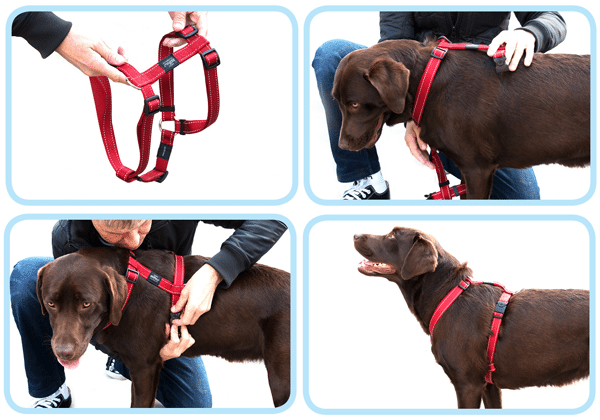
Wondering how the harness goes on the dog? Well, there are two ways to make your dog wear a harness. The first one is a step-in harness, and the other one is an overhead harness. Both work pretty well, but you need to select them based on your preferences.
1. Step-In Harness
- Step 1: First, lay the step-in harness on the ground. This harness has a 2 leg loop separated by a strap in the middle. Spread out the loops for your dog to put their legs into each.
- Step 2: Pick your dog’s right paw and gently put it in the right loop, and take the left paw and put it inside the left one. There are harnesses where any paw can be put in any loop. So, read the instruction manual carefully for more information.
- Step 3: Now, pull the harness upwards and place it evenly on your dog’s chest and not just the neck. Tug the side straps over your dog’s shoulder onto their back and snap the clips securely.
- Step 4: Now, using the plastic pieces, tighten or loosen the straps accordingly. Ensure the strap is not too tight, as it can restrict your dog’s movement. Adjust the harness whenever needed.
2. Overhead Harness
- Step 1: Before making your dog wear an overhead harness, teach them to follow instructions like ‘sit’ and ‘stay.’ It is easier to make them wear this type of harness when they sit still.
- Step 2: Also known as a standard harness, you must lift the smaller loop over your dog’s head and ensure it is not too high on your dog’s shoulder.
- Step 3: Now, lift your dog’s paw and slide it into the closed loop. These loops can be on the left or right side, so read the manual properly.
- Step 4: Now, take the other strap and put it under and behind your dog’s leg. This will let you control your dog better. Make sure that the slip is securely fastened.
- Step 5: Now slide the adjusters accordingly to tighten or loosen the straps. Ensure that it is not too tight, digging into your dog’s skin, and not too loose that it isn’t secure enough.
Most importantly, once your dog has worn the harness, don’t forget to give them a treat. This way, they will always be happy wearing a harness, knowing a treat awaits them. Lastly, you need to attach a leash, and you can follow the steps below to do it easily.
- Step 1: All harnesses have a leash clip. They are typically shaped as a ‘D’. Ensure you are attaching the leash only to the clips, as in other places, there is a chance of breakage under pressure.
- Step 2: Back clips help in comfortable movement if your dog does not pull or jump. It is the best way for small dogs that have sensitive necks.
- Step 3: You can attach the leash to the front. This provides you with more control over your dog. However, they can easily get tangled, so stop and untangle them first.
Which Type of Harness is Best for Your Dog?
Before you decide to buy a dog harness, you need to go through some essential features. Considering these features lets you select the right type of harness for your dogs. Check these features below:
1. Material of The Harness
It would be best if you got a harness made out of soft material that does not harm your dogs. You can even go with a durable metal option for the D-ring clip. The harness should not be a hindrance when it comes to their walking.
2. Weight of The Harness
Avoid buying a heavy harness. Rather, get a lightweight one, and you can carry it wherever you go.
3. Harness with Adjustable Belts
It would be best to have a harness that fits your dog right. But at the same time, you can also get one with an adjustable belt. This gives them a perfectly customized fit.
4. Presence of Reflective Straps
Get a harness that has a reflective strap feature. It makes your early morning walks and evening walks safe.
5. Harness that is Easy to Use
Get a user-friendly harness, that is, something that is easy to put on and take off. Do not go for any complicated features in a harness.
6. Check if The Design is Safe
As a dog owner, you will always want the best product for your fur companion. Before getting a harness, check its non-pulling feature, no choke design, and whether it has padding to protect your dog’s skin from injury.
Conclusion
Harnesses are not just functional but also can be customized according to needs and preferences. The versatility, comfort, and safety are top-tier, thus making it a dog owner’s favorite. If your dog is injured and has neck problems, harnesses can work for the best. Thus helping in the physical well-being of your dogs. Harnesses help in better leash training and behavior modifications.
You can choose from the different types of harnesses available in the market. It also depends on your dog’s comfortability. Also, you need to make sure that you know how the harness goes on the dog. They provide a better grip on your dog, whether you are out on an adventure or a training session.
Frequently Asked Questions
Why Should I Get a Harness Instead of a Collar for My Dog?
If your dog has neck issues or injuries, it is always advisable to use a harness instead of a collar. Harness distributes pressure evenly across your dog’s chest and back and thus provides comfort.
Is It Right to Use Harnesses for All Breeds of Dogs?
Harness is a great option for almost all dogs. However, you can use a collar for your small-sized dogs. It would be best to use a harness for big-sized dogs that are more active and pull-prone.
Is It Okay if My Dog Wears a Harness All the Time?
It would be best if you did not make them wear a harness all the time. Give them breaks as they might get uncomfortable using it all the time. Check for rashes if they have been wearing it for a long time.
How Do I Clean My Dog’s Harness?
Cleaning a harness is possible, but before doing that, you need to read the instructions given in the manual. Most of the harnesses are washable using mild detergent. Also, keep checking for any damage to the harness and if it needs to be replaced.
Can I Use a Harness for Senior Dogs?
Yes, you can surely use a harness for your senior dogs. If your dogs are suffering from arthritis or have some health issues, the harness can be helpful. But make sure you get a padded one for their comfort.

